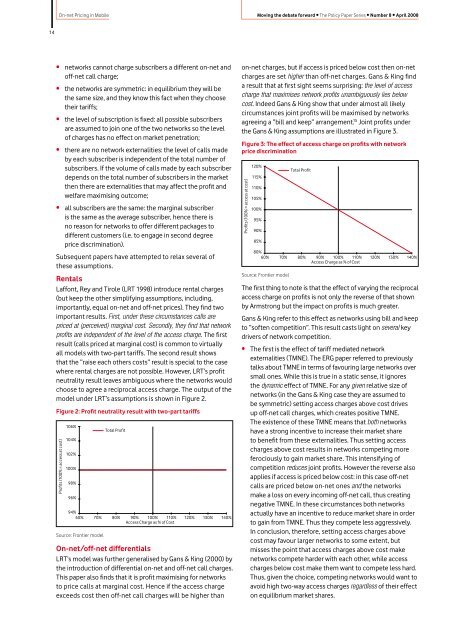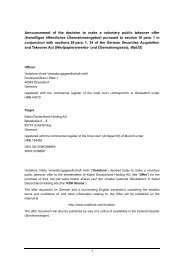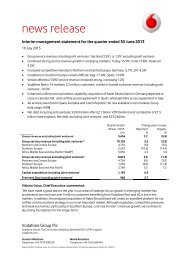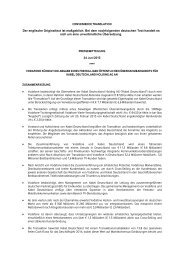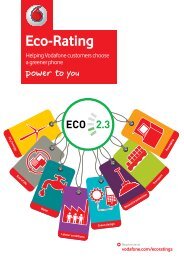Create successful ePaper yourself
Turn your PDF publications into a flip-book with our unique Google optimized e-Paper software.
14<br />
On-net Pricing in Mobile Moving the debate forward • The Policy Paper Series • Number 8 • April 2008<br />
• networks cannot charge subscribers a different on-net and<br />
off-net call charge;<br />
• the networks are symmetric: in equilibrium they will be<br />
the same size, and they know this fact when they choose<br />
their tariffs;<br />
• the level of subscription is fixed: all possible subscribers<br />
are assumed to join one of the two networks so the level<br />
of charges has no effect on market penetration;<br />
• there are no network externalities: the level of calls made<br />
by each subscriber is independent of the total number of<br />
subscribers. If the volume of calls made by each subscriber<br />
depends on the total number of subscribers in the market<br />
then there are externalities that may affect the profit and<br />
welfare maximising outcome;<br />
• all subscribers are the same: the marginal subscriber<br />
is the same as the average subscriber, hence there is<br />
no reason for networks to offer different packages to<br />
different customers (i.e. to engage in second degree<br />
price discrimination).<br />
Subsequent papers have attempted to relax several of<br />
these assumptions.<br />
Rentals<br />
Laffont, Rey and Tirole (LRT 1998) introduce rental charges<br />
(but keep the other simplifying assumptions, including,<br />
importantly, equal on-net and off-net prices). They find two<br />
important results. First, under these circumstances calls are<br />
priced at (perceived) marginal cost. Secondly, they find that network<br />
profits are independent of the level of the access charge. The first<br />
result (calls priced at marginal cost) is common to virtually<br />
all models with two-part tariffs. The second result shows<br />
that the “raise each others costs” result is special to the case<br />
where rental charges are not possible. However, LRT’s profit<br />
neutrality result leaves ambiguous where the networks would<br />
choose to agree a reciprocal access charge. The output of the<br />
model under LRT’s assumptions is shown in Figure 2.<br />
Figure 2: Profit neutrality result with two-part tariffs<br />
Profits (100% = access at cost)<br />
106%<br />
104%<br />
102%<br />
100%<br />
98%<br />
96%<br />
Total Profit<br />
94%<br />
60% 70% 80% 90% 100% 110% 120% 130% 140%<br />
Access Charge as % of Cost<br />
Source: Frontier model<br />
On-net/off-net differentials<br />
LRT’s model was further generalised by Gans & King (2000) by<br />
the introduction of differential on-net and off-net call charges.<br />
This paper also finds that it is profit maximising for networks<br />
to price calls at marginal cost. Hence if the access charge<br />
exceeds cost then off-net call charges will be higher than<br />
on-net charges, but if access is priced below cost then on-net<br />
charges are set higher than off-net charges. Gans & King find<br />
a result that at first sight seems surprising: the level of access<br />
charge that maximises network profits unambiguously lies below<br />
cost. Indeed Gans & King show that under almost all likely<br />
circumstances joint profits will be maximised by networks<br />
agreeing a “bill and keep” arrangement. 15 Joint profits under<br />
the Gans & King assumptions are illustrated in Figure 3.<br />
Figure 3: The effect of access charge on profits with network<br />
price discrimination<br />
Profits (100% = access at cost)<br />
120%<br />
115%<br />
110%<br />
105%<br />
100%<br />
95%<br />
90%<br />
85%<br />
Total Profit<br />
80%<br />
60% 70% 80% 90% 100% 110% 120% 130% 140%<br />
Access Charge as % of Cost<br />
Source: Frontier model<br />
The first thing to note is that the effect of varying the reciprocal<br />
access charge on profits is not only the reverse of that shown<br />
by Armstrong but the impact on profits is much greater.<br />
Gans & King refer to this effect as networks using bill and keep<br />
to “soften competition”. This result casts light on several key<br />
drivers of network competition.<br />
• The first is the effect of tariff mediated network<br />
externalities (TMNE). The ERG paper referred to previously<br />
talks about TMNE in terms of favouring large networks over<br />
small ones. While this is true in a static sense, it ignores<br />
the dynamic effect of TMNE. For any given relative size of<br />
networks (in the Gans & King case they are assumed to<br />
be symmetric) setting access charges above cost drives<br />
up off-net call charges, which creates positive TMNE.<br />
The existence of these TMNE means that both networks<br />
have a strong incentive to increase their market share<br />
to benefit from these externalities. Thus setting access<br />
charges above cost results in networks competing more<br />
ferociously to gain market share. This intensifying of<br />
competition reduces joint profits. However the reverse also<br />
applies if access is priced below cost: in this case off-net<br />
calls are priced below on-net ones and the networks<br />
make a loss on every incoming off-net call, thus creating<br />
negative TMNE. In these circumstances both networks<br />
actually have an incentive to reduce market share in order<br />
to gain from TMNE. Thus they compete less aggressively.<br />
In conclusion, therefore, setting access charges above<br />
cost may favour larger networks to some extent, but<br />
misses the point that access charges above cost make<br />
networks compete harder with each other, while access<br />
charges below cost make them want to compete less hard.<br />
Thus, given the choice, competing networks would want to<br />
avoid high two-way access charges regardless of their effect<br />
on equilibrium market shares.


